No products in the basket.
Art History
Who is revolutionary artist Ai Weiwei? And a discussion of 11 of his most prolific artworks
What are the most important artworks by Ai Weiwei you should know?
Introduction
Ai Weiwei is a Chinese contemporary artist and activist. He has been called the most dangerous artist in the world. He has been arrested and detained for 81 days, his art studio has been demolished, not once but twice!
He has been accused of tax theft, his passport has been confiscated and he has been placed under surveillance. But why? How can this man be one of the most renowned artists of our time? How can someone that’s been to jail be seen as the most powerful artist in the world? Why is Ai Weiwei’s art so powerful and important?

It is because Ai Weiwei is passionate about human rights and openly critical of the Chinese Government. He has investigated Chinese government’s corruption and lies and spoken about them openly. Needless to say the Chinese Government doesn’t like that one bit.
His political outspokenness has triggered various forms of harassment from the Chinese Government. Ai Weiwei and his art is loved by the world but hated by his own country’s government.
As an artist he is known for his ready-made sculptures, massive installations, performances, photographs, videos, investigations, architectural projects, social media updates and blog posts. He truly is a diverse artist that will simply not be silenced.
In the current art world we see a large spectrum of artworks. Ranging from a banana stuck on a wall to intricate paintings that feel so real you could grab it from the canvas. I like to think of art on this scale. One the one side we have human printers that are exceptional at craftsmanship and technical art skills. On the far left we have the cognitive aspect of the art, the part that is conceptual and challenges our way of thinking, I like to call it brain gymnastics. Ai Weiwei leans more to the conceptual side of things with strong messages and opinions.
Let’s delve deeper into Ai Weiwei’s life and discover why he is so passionate about freedom of speech and human rights.
Art is a tool to set up new questions
Ai WEIWEI
The life of Ai Weiwei
A little fighter is born
Artist Ai Weiwei was born in 1957 China. Ai’s father was one of China’s renowned poets and his mother a writer. Ok so that date is important. Let’s backtrack just a bit and give you a short overview of Chinese History so you can understand what happens next.
China through the ages
In short the History of China is old and stretches over a loooong timeline. China’s history is divided into periods called Dynasties. Every dynasty was ruled by one important man (sometimes woman) called an Emperor. During this time China was known for various inventions such as fireworks and gunpowder.
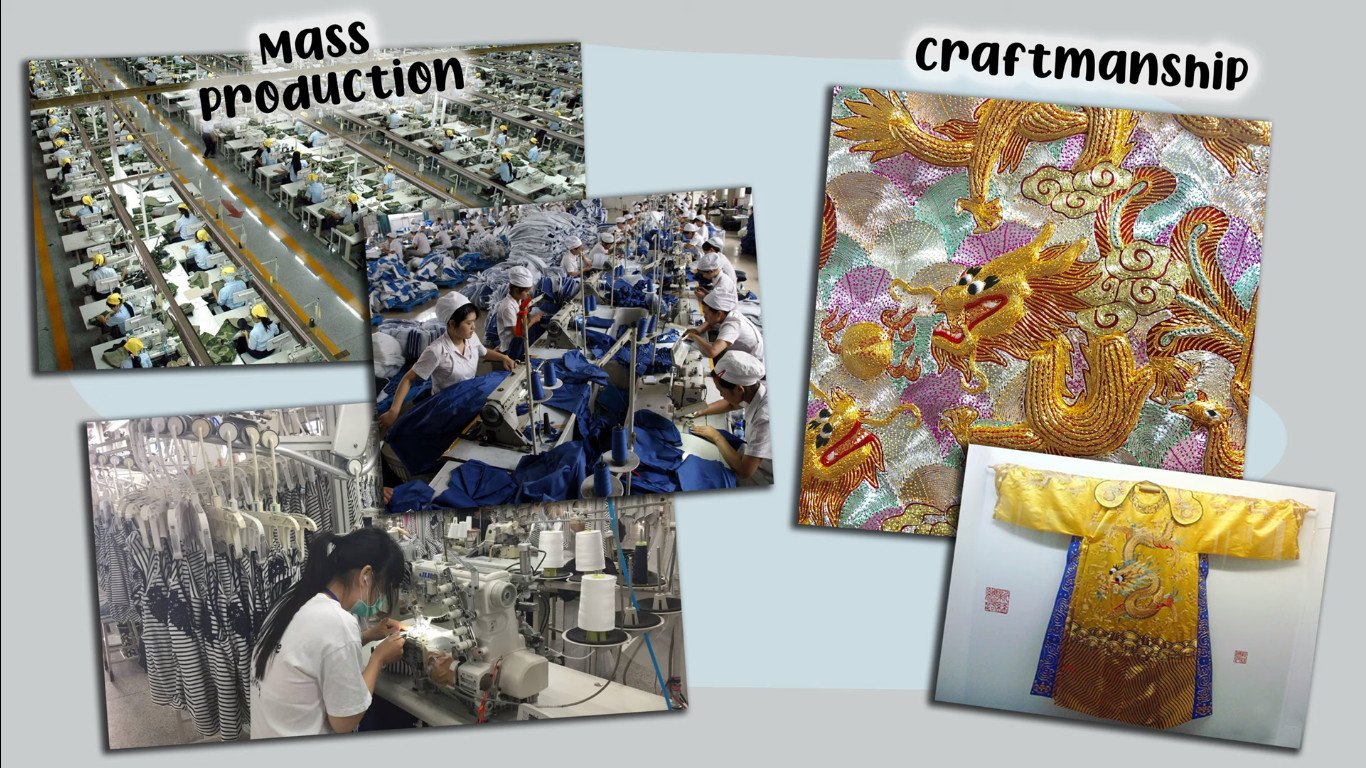
They also become known for exceptional craftsmanship and art skills such as ceramics, calligraphy, woodcuts, painting and joinery. Chinese society was also based on the philosopher Confucius’ work which preached, a certain societal structure, respect and dignity within the community.
Fast forward to 1911 and we have China’s first revolution. This ended over 3000 years of dynastic history. During this time all across the world poor people were sick of being ruled by the wealthy. Nationalist took over from the ruling Emperor but then the Communist challenged them. Civil war broke out in China between the Nationalists and the Communists, eventually the Communists won.
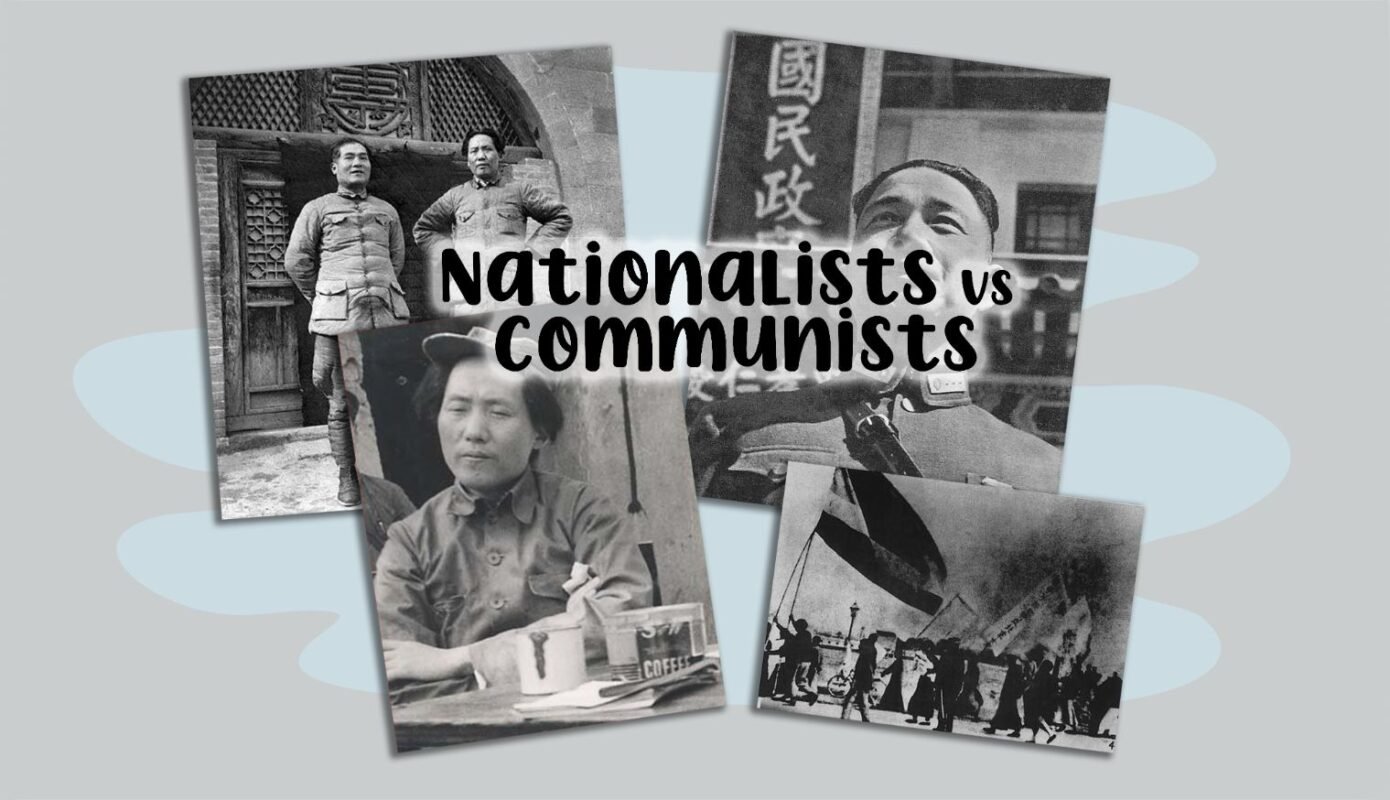
A short history of Communist China
That brings us to the 1st of October 1949. When the charming charismatic leader Mao Zedong declared the People’s Republic of China. Mao Zedong was a dynamic new leader that made lots and lots of promises to the people of China.
However he didn’t really keep any of them. Mao launched a massive propaganda campaign spreading his own importance and Communist beliefs. He even had a little red book that everybody in China simply had to own. I mean literally, it was mandatory to have one.

However Mao didn’t really know how to rule China and he made lots and lots of mistakes, but whenever anyone criticised him he simply had them silenced a.k.a killed. But Mao had a strong vision for China, he wanted to build an industrialised China filled with factories.
So Mao came up with a terrible plan called “The Great Leap Forward” Spoiler alert, it didn’t work. 20 million Chinese people died of hunger half of which were under the age of 10 (1959 and 1962)
“Political power grows out of the barrel of the gun…”
Mao zedong
Off to a labour camp
Ok so back to Ai Weiwei, the year is 1958 and the dictator Mao Zedong is in control of China. His plans to unify and save China is going badly. Ai is 1 year old when his dad gets accused of not agreeing with Mao in his poetry. No one is allowed to tell supreme leader Mao he is wrong; he simply hates it. So Communist officials send Ai’s dad and his entire family off to work in Chinese Labour Camps.

They lived in these harsh conditions for over 17 years!
Back to Beijing
In 1976 Mao Zedong died and Ai’s family was allowed to return to Beijing. This signaled the end of the Cultural Revolution in China. (1966 – 1976)
A keen interest in art and film.
In Beijing Ai developed a keen interest in art and film. He enrolled in the Beijing Film Academy. Soon he established a student avant-garde art Group called Stars (Xingxing in Chinese). Today this group is seen as the birth of the Contemporary Chinese Art Movement. It was a rebirth of art forms that were suppressed for decades by Mao’s Communist Rule.
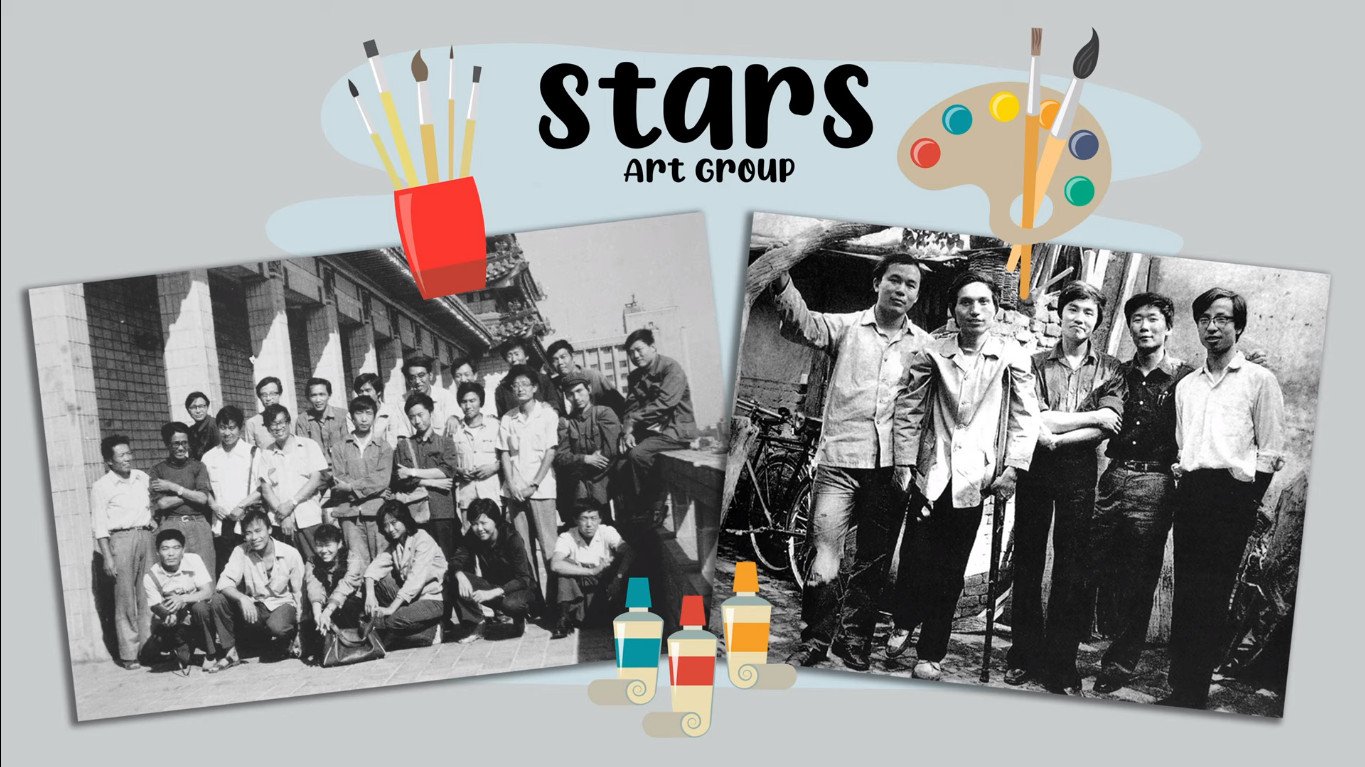
However Mao’s death didn’t end communist rule in China, it just continued under a new leader. This didn’t make it easy for artists to show their work and be heard. But Ai and his friends didnt give up. When they were denied entry to their exhibition space, they hung their work on the railings outside the building, even when the government declared it illegal.

When the police shut them down, they protested in the streets. Eventually the government allowed Stars to exhibit in the China Art Gallery. They expected that the lack of interest from the public would deter the determined artists. However a whopping 200,000 visitors attended the attraction.
Leaving China for America
Eventually Ai Weiwei grew tired of the Chinese restrictions on artists and in 1981 he moved to the United States of America. He settled in New York city and attended Parsons School of Design. He immersed himself into art studying Marcel Duchamp’s ready made sculptures, Andy Warhol’s repetitive prints, Jasper Johns soft sculptures and the German artist Joseph Beuys sculptures. Ai became fascinated with ready-mades.

Readymades are when an artist takes a found object, strips it from its daily use, then displays it in a different way and adds a title. By doing this the artist adds a new thought and meaning to the object that it did not previously have. The object then becomes an artwork.

Back to a ‘Modern’ China
After 12 years in New York, Ai returned to China because his father became sick (1993). China was undergoing tremendous change with huge Economic development. You see in 1978 a new leader Deng Xiaoping decided that China was ready to do business with the West.
Deng is seen as the Architect of Modern China, he implemented a program for Economic reforms. Establishing Social Economic Zones(SEZ) in China. These zones didn’t have to follow the same rules as the rest of China and were allowed to export products to the West.
The Chinese government was still Communist, but they desperately needed to come up with new ideas to be able to feed 1.4 billion people. They needed Capitalism but didn’t want to give up their communist control. So they made these SEZ zones and called it Socialism with Chinese Characteristics. And it worked. Much better than anyone expected.
But this aggressive strategy to become an economic powerhouse came with radical change. Entire neighborhoods were demolished to build new roads, dams, stadiums and high rise buildings.
Erasing the past
The way the government was just erasing thousands of years of Chinese history troubled Ai. He was shocked to see nobody was interested in owning beautiful objects from past dynasties.
“I still have a photo of when I was in Xi’an. There was a farmer sleeping on top of these two 2000-year-old urns waiting for someone to pay him a few hundred yuan. For him, that was a few months’ salary, but even then nobody wanted them.”
AI WEIWEI
He was also troubled by how the Chinese Government wanted to sweep the failures of communist rule under the carpet and simply just erase history.
If a nation cannot face its past it has no future
AI WEIWEI
You see Ai is well versed in antiques and knew the value of historic Chinese objects. He wanted to confront the Chinese people with the past. He wanted to remind them of the Dynasties that came before.
He wanted to show them the exceptional craftsmanship China command in contrast with the cheap mass manufactured items it has become known for. He wanted people to respect the past so they can consider the type of future they were currently creating.
Ai started using Chinese Antiques for his ready made sculptures, combining and assembling them in unique ways. By using these ancient items in contemporary sculptures he made Chinese History striking and visible to the public again.
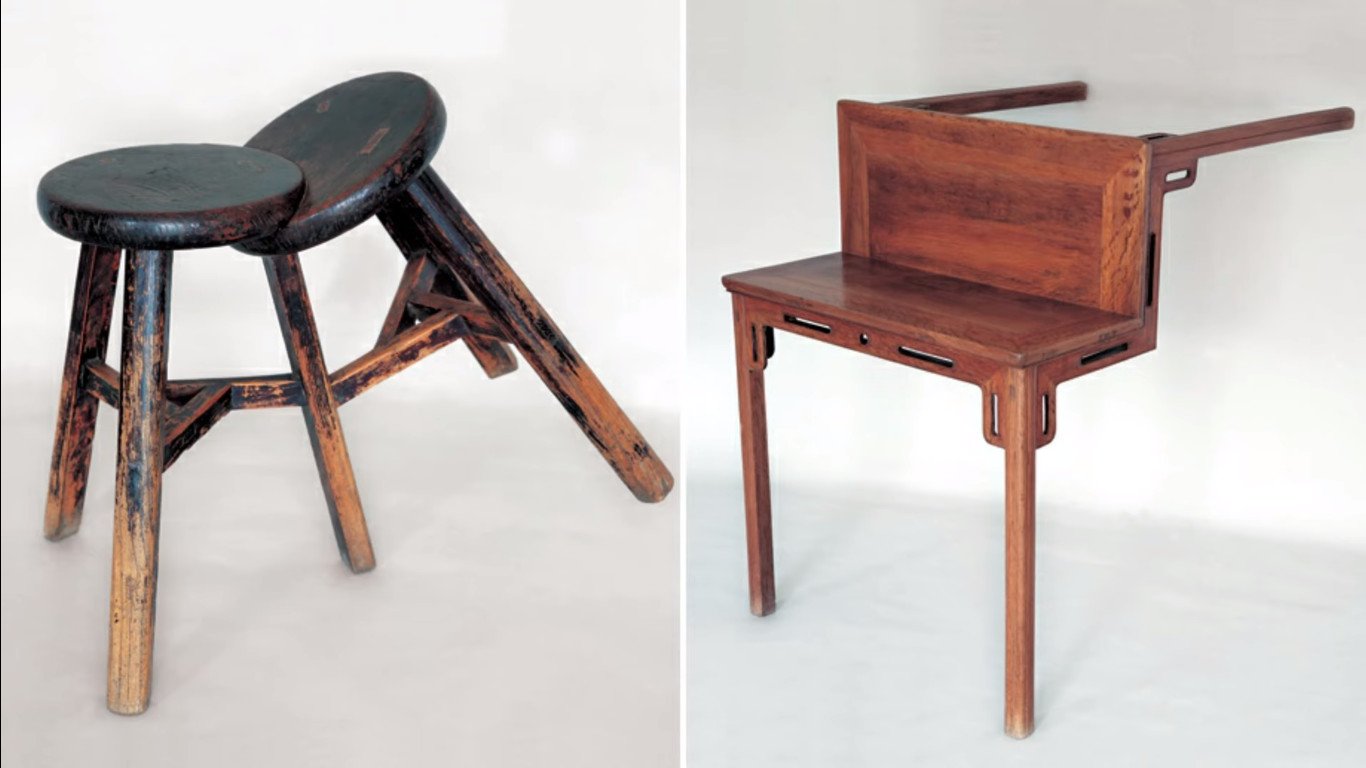
One example of this is when Ai transformed a centuries-old Han Dynasty urn into a modern artwork by slapping a Coca Cola logo onto it (1994). Another example was when he gathered doors from demolished Chinese temples for a massive public installation.

Breaking Chinese Traditions
A particular piece that gained a lot of attention was when Ai smashed a 2,000-year-old Han dynasty urn. (Dropping a Han Dynasty Urn – 1995) He captured the action with a triptych of photographs showing us frame by frame how he drops it and shatters it.
Ai is also looking directly into the camera defiantly and fully aware of the destruction he is about to cause. He literally simply smashed something that was super rare and more than 2000 years old. Shocking!

How can you simply break something that old? Is it pure vandalism! By breaking the urn Ai actually made people notice it more. It made them ask why is it valuable? Why should we care about it? This artwork serves as a mirror reminding us that China’s past remains important and relevant today.
Ironically by destroying the urn he revitalised it. It is destruction as preservation. The Han dynasty urn still exists for the public but it has been transformed into photos. These photos now receive unprecedented attention and they are displayed in museums and public institutions all around the world.
Given Ai’s own celebrity status and the significance of this artwork, Dropping a Han Dynasty Urn is also now far more valuable than the original ceramic object. In 2016, this limited edition work sold for nearly 1 million dollars at Sotheby’s Auctions in London.
“People always ask me: how could you drop it? I say it’s a kind of love. At least there is a kind of attention to that piece.”
AI WEIWEI
Dropping a Han Dynasty Urn is one of many works by Ai Weiwei that focuses on heritage loss and the importance of the past. Throughout Ai’s art career he has done various artworks and installations surrounding the theme of celebrating China’s long rich history prior to Communism.
To celebrate China’s ancient skills he often hires Chinese craftsmen skilled in ancient joinery, porcelain and ceramics to work with him on projects. By embracing these painstaking handmade skills he poses a strong contrast to China’s mass production. This also allows Ai to focus and celebrate an individual person’s skill which isn’t done in Communist China.
Blossoms at Alcatraz prison 2014
An artwork that depicts Ai Weiwei using Chinese’ Craftsmanship is an installation he did at Alcatraz Island, in the USA. Alcatraz is the former home of a military fortification and military and federal prison. Through seven new sculpture, sound, and mixed-media works, the acclaimed artist explores human rights and freedom of expression.
They are in striking contrast to the cold, haunting rooms that boast so sad and sinister a history. The works are even more powerful with the knowledge that Weiwei himself was detained in 2011, for 81 days.
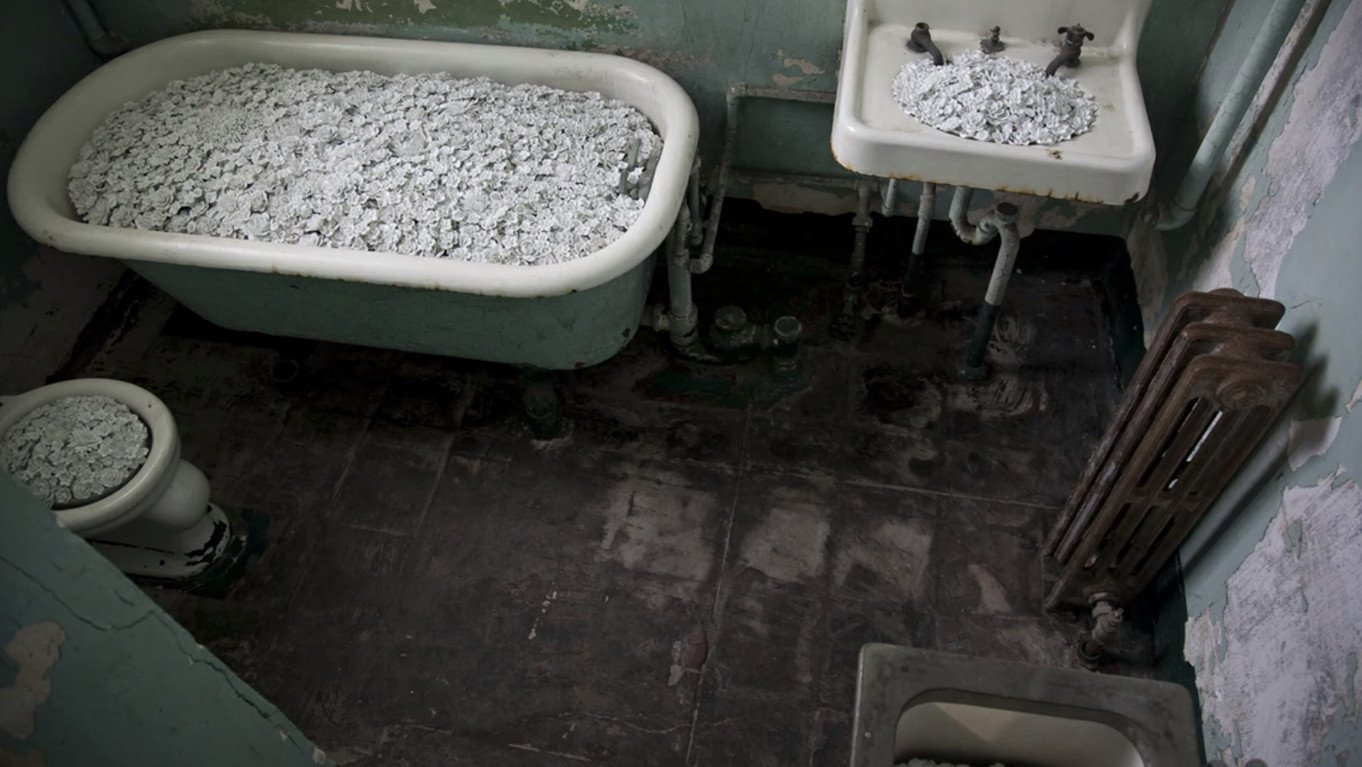
The most striking of the works is Blossom, an installation in Alcatraz’s old medical wing. Weiwei fills the toilet bowls, sinks and bathtubs in the former prisoner bathrooms with ceramic flowers. It’s remarkable. On an aesthetic level, the flowers are beautiful: white, delicate and growing in abundance through the dirty crevices.
Weiwei is still forbidden to leave China so it is fascinating to think he created the work without seeing the locations himself. He developed the works in his Beijing studio with support from the presenting partners, Bay Area volunteers, and Amnesty International, which provided research material.
The misconception of totalitarianism is that freedom can be imprisoned. This is not the case. When you constrain freedom, freedom will take flight and land on a windowsill
Ai Weiwei
Some have suggested the work may be an ironic nod to China’s famous Hundred Flowers Campaign of 1956, a brief period of government tolerance of free expression, which was immediately followed by a severe crackdown against dissent. Chairman of the Communist Party Mao Zedong Mao named this liberalization movement the Hundred Flowers Campaign, after a traditional poem: “Let a hundred flowers bloom / Let a hundred schools of thought contend.”
China and Human Rights
Ok so now you need to know a little bit more on how Communist China works. In the West we believe in basic human rights, such as all people are equal regardless of race, colour or gender, we believe in the freedom of religion, we believe in the freedom of speech and we believe in democracy. The West doesn’t have it all figured out and their Democartic system can seem very messy at times. But these are the ideals the strive for.
Freedom of speech is really important because it keeps leaders honest and in check. Now in China you are not allowed to criticize the government. If you do they will harass, imprison and even torture you.
Because Freedom of speech is not allowed the internet is also monitored by the government, meaning they decide which website you are allowed to spend time on and view.
So in China social media such as Facebook, Twitter, Instagram and Youtube isn’t allowed. So the Chinese Government is essentially in control of everyone, what they do, what they watch, what they say and ultimately that leads to controlling the population’s thoughts.
Communism is also based on the belief that the state, the government owns everything and then they decide to share it with everyone equally. You are not allowed to own anything. Even your body and your brain belongs to the government.
Ok so now that you know this lets move on to other artworks by Ai Weiwei.
Past and present
Artist Ai Weiwei is not only concerned with the past but also with the present. He is particularly concerned with the way the Chinese Communist Government hides the truth from the public.
On May 12, 2008, a massive earthquake in China’s Sichuan province killed approximately 90,000 people. 10 Days after the 8.0 magnitude earthquake Ai led a team of people to survey and film the post-quake conditions.
They discovered that due to corruption various schools campuses were built quite shoddily and did not adhere to standard building regulations. This caused lots of schools to collapse and resulted in the death of many children.
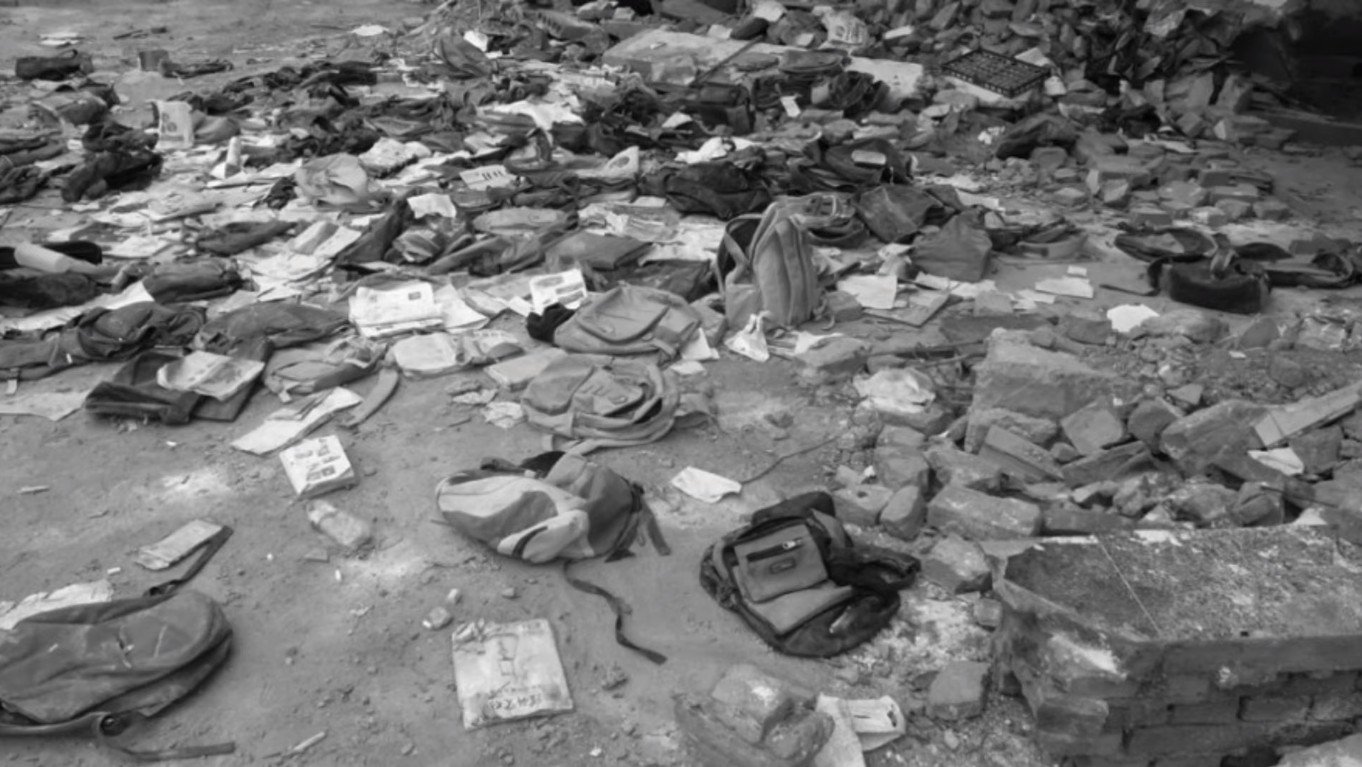
The government, not one to admit fault, denied the allegations and refused to publish the amount of people that perished. They also refused to launch an investigation into the corruption or accept any responsibility.
In response Ai recruited volunteers online and launched a “Citizens’ Investigation” to compile names and information of the student victims. Ai wouldn’t allow the Chinese government to simply deny the children’s deaths. Ai and his team soon accumulated a list of 5385 children’s names that died in the earthquake.
They were meticulous gathering each child’s home address, age, gender, parent names and the schools they attended in the area. Ai published the collected names as well as numerous articles documenting the investigation on his blog but the Chinese authorities quickly shut down the blog in May 2009. Remember they control the internet.
But this didn’t stop Ai. He was determined to remember these children and their parents suffering. He made several artworks commemorating the incident and exposing the Chinese Government corruption.
“To remember the departed, to show concern for life, to take responsibility, and for the potential happiness of the survivors, we are initiating a “Citizens’ Investigation.” We will seek out the names of each departed child, and we will remember them.”
Blog post by artist Ai Weiwei 20 March 2009
Straight 2008
In one artwork he collected bent metal rods from the collapsed schools in Sichuan, 150 tons of rebar to be exact. He painstakingly straitened the 150 tons of rebar and then exhibited them in stacks. By straightening the pieces Ai Weiwei demonstrates his desire to try to make things right for the forgotten victims of the earthquake. This exhibit called STRAIGHT was displayed at the 2013 Venice Art Biennale.
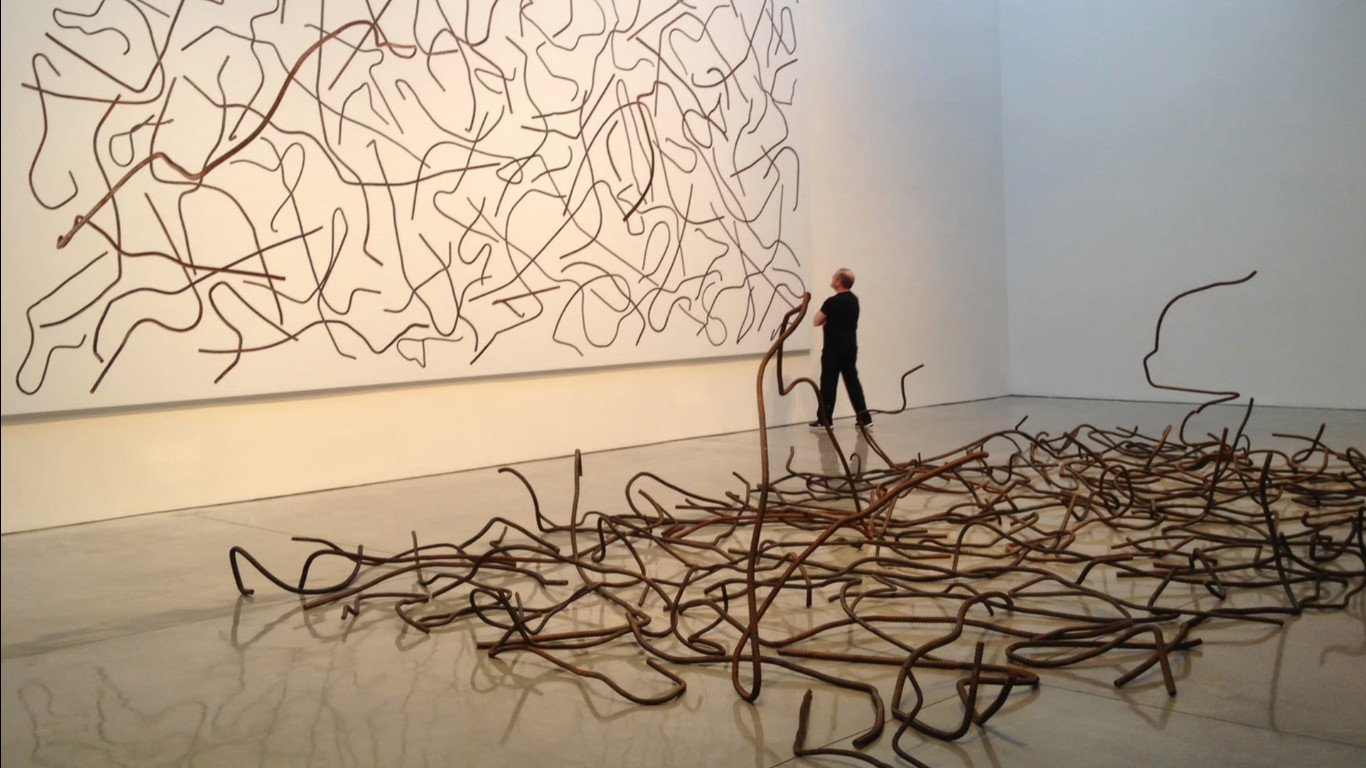

Say their names 2008
He also exhibited the list of 5200 school children that died. 300 people came together at the Art Gallery of Ontario for a community art performance called Say Their Names, Remember.
During this four-hour event, participants read aloud the names of all the children. As you stand in front of this installation at the art gallery you can hear the names being read aloud.
“Can these facts be altered? The hearts stopped beating, their limbs decayed, and their shouts disappeared with their breath, can these be returned? Wave upon wave of mighty propaganda from the national state apparatus cannot erase the persistent memories of the survivors. People’s hearts will call out each of your names, the name that belonged to you will be remembered. When it is called out again, you will rise from the dead and be content spirits.”
Ai Weiwei
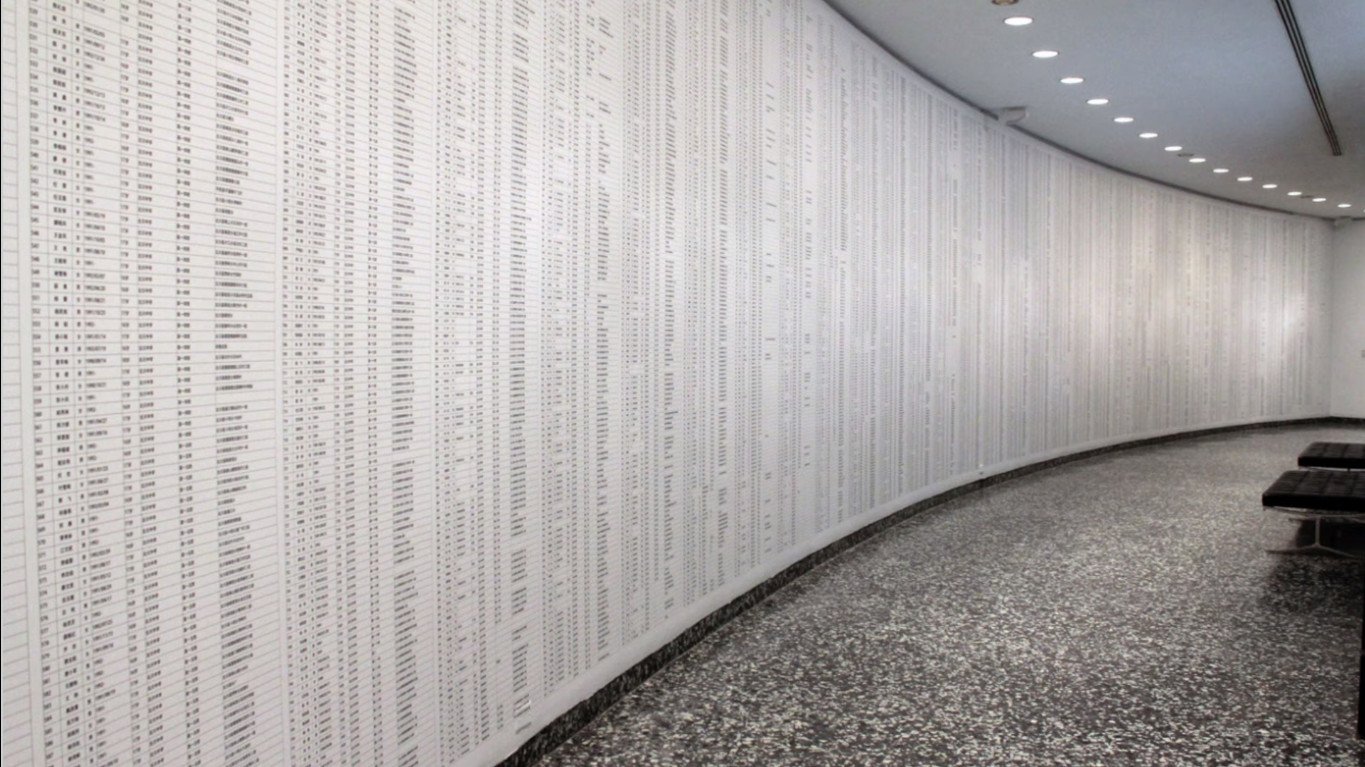
Snake Bag 2008
When Ai Weiwei visited the sites of the schools that had been destroyed he saw children’s backpacks scattered in the rubble, a tangible symbol of the boys and girls whose lives had been cut short. He decided to use the backpack as a symbol for each child that died. The work is made of hundreds of backpacks latched together in the shape of a snake.
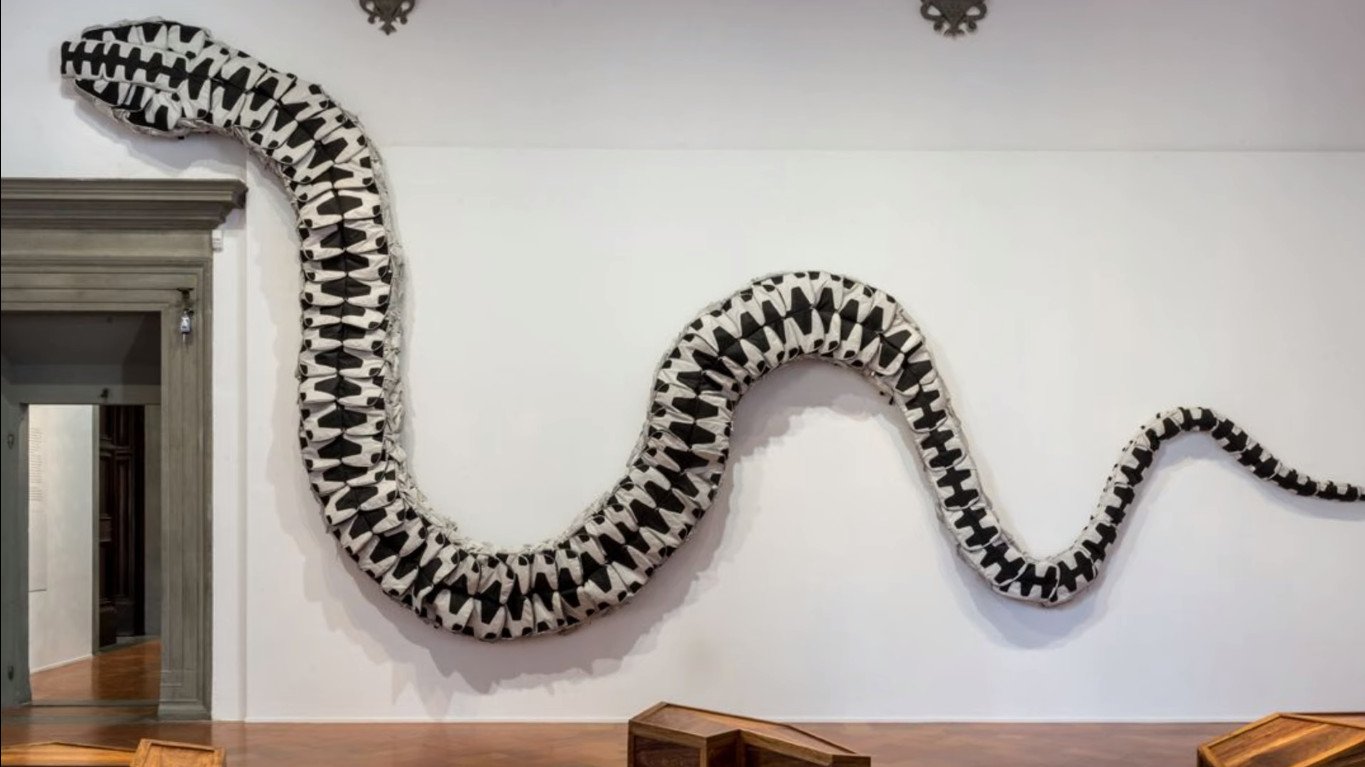
Remembering 2009
He also created a simple yet moving installation on the facade of Haus der Kunst in Munich. He used 9000 school backpacks to spell out the words “She lived happily for 7 years in this world” in Chinese. It was a quote from one of the mother’s he interviewed in his investigation.
She lived happily for 7 years in this world
A victims mother
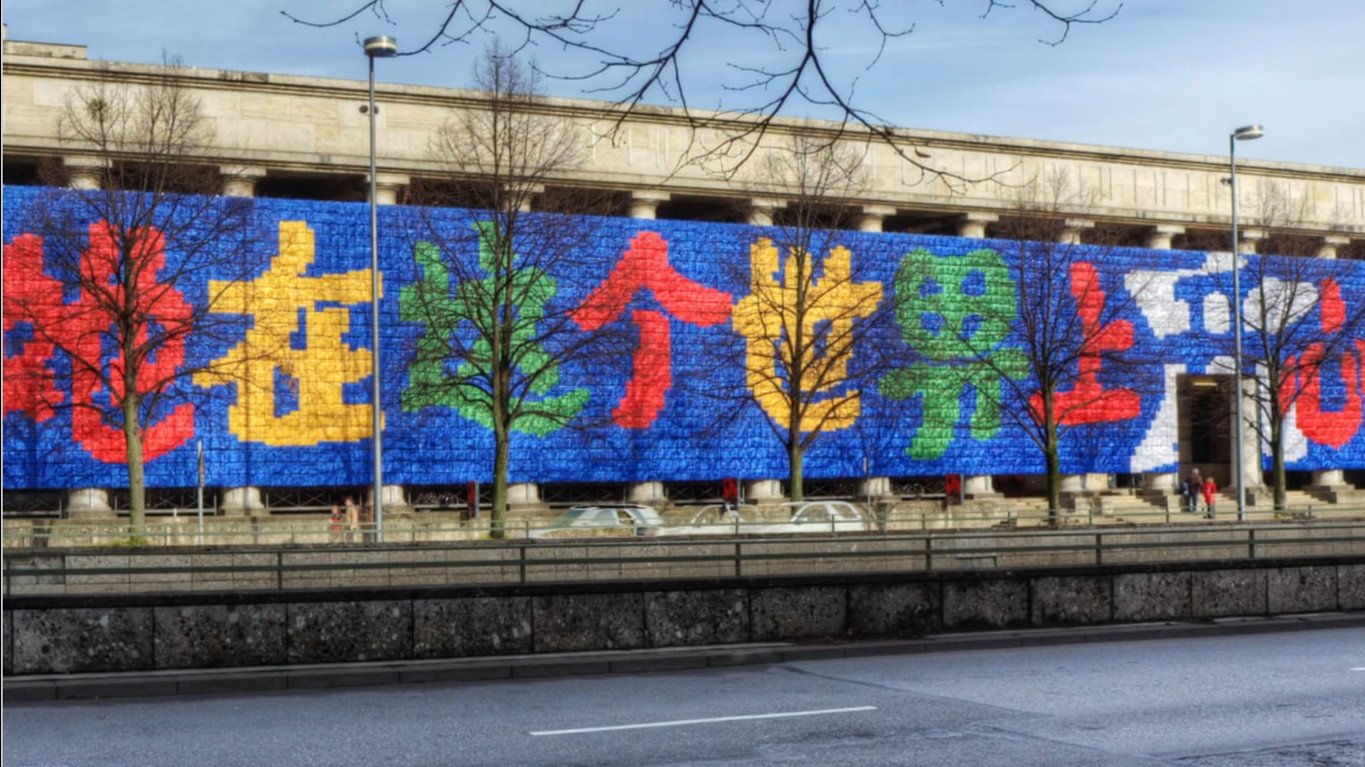
Sunflower seeds 2010
The artwork Sunflower seeds consists of more than 100 million tiny, handmade porcelain sunflower seeds. Yes hand made!
“ At first people will have the impression that these are real sunflower seeds because they are fake seeds. It will take them a while to adjust their minds. Some people will even put it in their mouth to try.”
Ai Weiwei
The sunflower seeds were hand made one by one in a small town in China that used to be known for their porcelain skills. The porcelain process consists of about 30 different steps, mining, milling, straining, painting, baking etc. This artwork involved 1600 people in this little village.
That means almost everybody knew somebody who worked on a sunflower seed. Once the porcelain seeds were made they all had to be hand painted. Each side of the seed takes about 3- 4 strokes with a brush.

Why sunflower seeds? Well first of all they bring up fuzzy feelings of joy in Ai from when he was growing up. Even the poorest in China would share sunflower seeds as a treat among friends.
More importantly the sunflower is a recurring symbol in Communist China Propaganda. Supreme leader Mao Zedong was often depicted as the sun and the people of China as the sunflower turning towards him. By using the seeds Ai Weiwei symbolises the camaraderie of Chinese people during difficult times.
In this work Ai plays with the role of the individual compared to the collective. Every single one of the 100 million sunflower seeds are carefully crafted and captures the viewers attention. Yet the large square of seeds covering the room’s floor creates a sense of vastness. This plays with the Communist ideology that the state “the Collective” is more important than the individual.
This project also states that it only could have been made in China and nowhere else. It alludes to the globalization and mass production in China that caters to western consumerism. It plays with the idea that the tiny seed is the insignificant individual at the bottom of the production chain. The thousands of cheap labourers in assembly lines, gigantic factories doing tedious procedures.
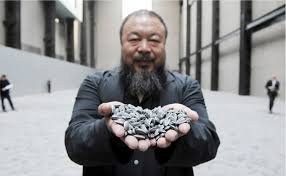
Beaten but not broken
Needless to say Ai became a huge irritation to the Chinese Government. He was a well known international artist that kept on exposing their corruption and lies internationally. Because Ai was a public figure they couldn’t just simply make him disappear…, you know kill him.
But they did decide to make life really difficult for him. In 2009, he was beaten by police after coming forward to testify against the construction work and student casualties during the earthquake. He suffered a cerebral haemorrhage and needed emergency brain surgery to recover.

Two of his bank accounts were hacked, his phone has been tapped, his 76-year-old mother interrogated and his personal blog shut down. In 2010 they placed Ai under house arrest, two months after his release they demolished his Shanghai studio.
After that the Chinese Government charged him with tax evasion demanding a total of over 12 million yuan (US$1.85 million). They placed him under continuous surveillance, had him followed and confiscated his his passport – preventing him from leaving the country. Later they destroyed his studio in Beijing.
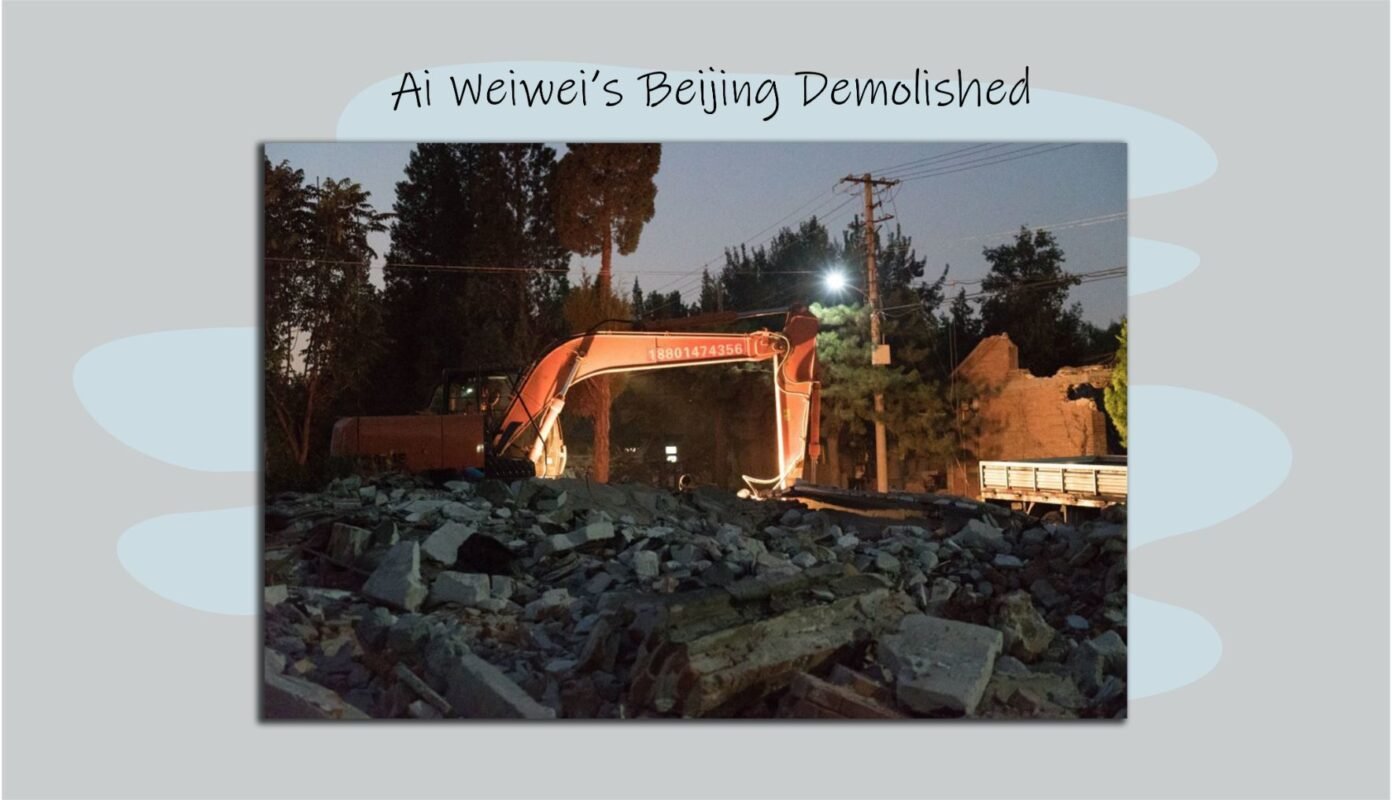
Arrested
In 2011 the Chinese government simply had enough of Ai Weiwei. They arrested him at Beijing International Airport for “economic crimes” They placed him in a secret prison for 81 days where they handcuffed him to a chair and interviewed him over 50 times.
No one knew where Ai was, including his family. Just imagine how terrible that must have been? International Public outcry ensued. This placed a lot of pressure on the Chinese Government to uphold their infallible image and Ai was eventually released and he emerged as a hero.
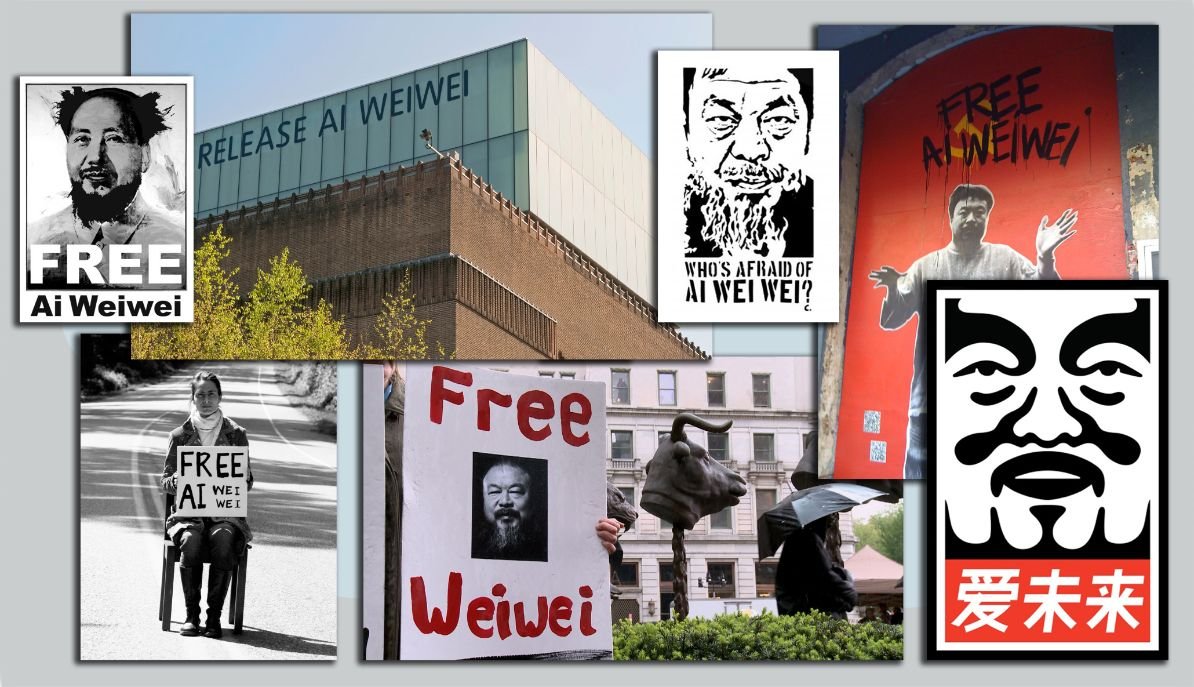
Leaving China
After being allowed to leave China in 2015, Ai moved to Berlin, Germany. In 2019 he moved to the UK. He currently still lives there with his family, working and travelling internationally.
Lego Portraits
This artwork consists of 43 Lego portraits of Mexican students who were reportedly abducted in a mass kidnapping and then killed in 2014. At least 80 suspects have been arrested in the case, 44 of whom were police officers. Featuring some one million Lego blocks, the exhibition is intended to be a commentary on the unsolved cases.

When Ai Weiwei was planning the artwork he placed a bulk order with Lego, but Lego refused to sell their blocks to him. Lego said it did not want to “actively support or endorse specific agendas.
” At first Ai Weiwei kept this news to himself. But a few weeks later, he saw an announcement that a new Legoland theme park would open in Shanghai, China. This led the artist to believe Lego had alternative reasons. China is Lego’s fastest growing market and the company wouldn’t want to irritate the Chinese Government. But they should have known better than to start a fight with the feisty Ai Weiwei.
Ai posted Lego’s decision to refuse to sell him their bricks on his social media channels. This sparked a public backlash. Ai’s fans started sending him lego from all over the world with the hashtag #LegosForWeiwei.

Ai Weiwei and his team quickly set up Lego collection sites around the world. Soon he had all the lego blocks he needed for his artworks. Since then Lego has changed their policy. They no longer ask people what the bricks will be used for when place bulk orders. Ai welcomed Lego’s change of heart.

I think Lego made a good move, I think this would be a small victory for freedom of speech.
Ai Weiwei
F Lotus 2006
Ai also fosucesse on humanitarian issues in other countries. In the artwork F Lotus he arranged 1500 life jackets from Syrian refugees in the shapes of lotus flowers for an installation in Vienna.
The installation features 201 rings – each with five life jackets – arranged into the shape of the letter F. Each of the rings has either red, orange or blue life jackets and floats like a lotus blossom on the pond at the park. Lotus flowers symbolizes rebirth and transformation.

However the installation form the letter F which alludes to an English swear word. Instead of rebirth these refugees will wait months for asylum with very little support. He created the installation as part of his continued campaign to raise awareness of the Syrian refugee crisis.
Law of the journey 2017
Law of the Journey is another artwork Ai Weiwei created ro raise awareness of the Refugee Crisis. It is a colossal black rubber raft bulging with 300 anonymous human figures wearing life jackets. The black rubber material was manufactured in a Chinese factory that also makes the hazardous vessels used by refugees who attempt to cross the Mediterranean Sea.

This artwork was accompanied by one of Ai Weiwei’s documentaries called Human Flow. For the documentary, Ai visited refugee camps in 23 countries, including Afghanistan, Bangladesh, France, Greece, Germany, Iraq, Israel, Italy, Kenya, Mexico, and Turkey.
The global humanitarian crisis is a subject close to Ai’s heart — as an activist, he’s now a Chinese refugee living in the UK.
Even we are living in a very peaceful world, almost like a fairytale in Australia, we still cannot disassociate our connections to other human beings, the suffering and the tragic life of our global human community.
Ai Weiwei at Sydney Biennale
Children and people you can see they’ve lost their lives in the journey searching for freedom, for safety, for some kind of shelter and compassion. But once they arrive in Europe, basically they’re being refused by all kinds of excuses. Politicians, policies and basically they are being neglected” – Ai Weiwei
Displaced Elephants in Myanmar
Ai is concerned with not only human injustices but also animals. In Myanmar elephants have long been valued for their hard work and ability to navigate the mountainous terrain. They are captured from the wild and forced into labour.
In 2014 Myanmar instituted a ban on raw timber exports in an effort to combat deforestation. As a result more than 5000 elephants were now jobless. They are now held in captivity and cannot survive on their own in the wild anymore.
“I relate to the elephants, there are a lot of small ones who have lost their parents. Elephants are like humans. Without parents, they cannot survive. They have to stay with them until they are seven years old.”
Ai Weiwei
In 2020 Ai released his first virtual artwork focusing on these elephants and their plight.
Social media lover
Ai is addicted to social media. In 2005, Ai was invited to start blogging by Sina Weibo, the biggest internet platform in China. He posted his first blog on 19 November. For four years, he turned out a steady stream of social commentary, criticism of government policy, thoughts on art and architecture, and autobiographical writings.
The blog was shut down in 2009. Today Ai’s blog is seen as one of the greatest works of performance art ever. Much in the way early performance artists documented with film and video, Ai used the prevalent medium of his time—the web—to examine the increasingly fine line between public life and the artist’s work.
2010 He Xie – 3,200 River Crabs
Another artwork by Ai you should know is He Xie. He created this work consisting of 3,200 handcrafted porcelain crabs. This is another artwork criticising the Chinese Government. Unfortunately understanding that message requires knowledge of Chinese!

The title “He Xie” means river crab, but in Chinese it also sounds like the word for “harmonious,” which is part of the Chinese Communist Party slogan. They say that they are a “harmonious society” but obviously Ai Weiwei, who has been the victim of their super intense censorship, disagrees.
Perhaps by making the connection to crabs he’s saying that their oppressive regime aims to make citizens all the same, like so many crabs caught in a trap, with no individuality or rights.
2014 Forever bicycles
Almost every household in China has a bicycle; it is a popular use of transport. Bicycles were always seen as a luxury in poor China. In Forever Bicycles, Ai used Shanghai-based Forever Company bicycles to make his massive installation.

It is the standard household brand for bicycles in China. Although bikes symbolized freedom and movement in China, the fact that they were stuck together in the piece could point to the status of the Chinese society today. The repetitiveness and the size of the installation were intended to allude to China’s mass production, which is well known to fuel the Chinese manufacturing industry.
Wuhan and Covid -19
Because artist Ai Weiwei is known to be outspoken, curious and an avid investigator, people were hoping he would expose the facts of what was happening in Wuhan when Covid-19 broke out. People on social media platforms were texting “We hope Ai Weiwei is in Wuhan.” Alas he wasn’t.
Ai is living abroad and it isn’t safe for him to ever return to China. He says he could return but will never be allowed to leave. In 2020 he released a documentary called Coronation about the Chinese government’s response to the growing health crisis in Wuhan and the origin of the COVID-19 pandemic. Ai directed a crew of volunteers to film the city’s strict lockdown measures and their impact on everyday life all the way from Britain!
Why celebrate Ai Weiwei’s art?
Ai’s art shows us how important freedom of speech is. It exposes the atrocities the government can commit that are not kept in check by a free media. He is passionate about pursuing truth. Currently in the world people are increasingly sceptical about trusting establishments and institutions.
They are flocking to alternative resources such as conspiracy theories and religion not based on science. Ai’s art explores our sources of truth and asks us to investigate the alternative motives of these sources.
Ai is an artist but also a human rights champion. He has been a seizless voice for the voiceless. He is a figurehead for justice. He is an adamant supporter of free speech. He refuses to be silenced. He offers resistance to forgetting. He demands respect for the past so we can transform the future.
His work asks us to consider what we value, why we value it, what we need to destroy, what do we need to preserve and what do we need to transform? We are not just asked to witness his artworks, we are called to action by it. We are invited to participate.
Liberty is about our rights to question everything
Ai Weiwei
Not everything he does is genius but he is committed to reaching a wider public.
I want people who don’t understand art to understand what I am doing
Ai Weiwei
And that’s the life and art of Artist Ai Weiwei. Yes, he is still a thorn in the side of the Chinese Regime, a constant irritation.
“I feel a lot of positive things about humanity even in the worst conditions, I don’t want to show that there is just sadness. Happiness and sadness always coexist. That’s a reason to protect that happiness.”
Ai Weiwei
BUY OUR AI WEIWEI WORKSHEETS
Worksheet pack that includes notes and fun activities. Ideal for art students and history students to learn more about the legendary artist Ai Weiwei


Pingback: Who is the influential street artist Shepard Fairey? - Lillian Gray - Art School